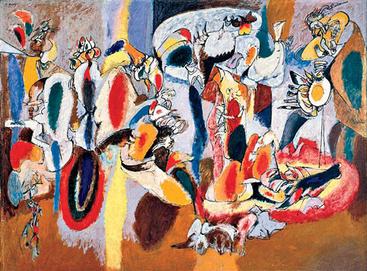The presentation will be a description of my studio work analysed in terms of the what, how and why my unique decisions have been made. As a rough guide, Dr Lister suggested that 30% of the mark is given for the what and how element and approximately 70% of the marking regime is given for the reflection and enquiry into why particular choices have been made.
- Therefore, all evidence of my own research will need to be included with comments on the focus of the work I have conducted throughout the year. I need to make comments on the themes I have chosen and upon what my work is based together with contextual investigations.
- It is essential to reference and discuss other artists that inspire me. It is here that I can explain the importance of Anselm Kiefer and other artists that I have referred to that are both critical and vital to an understanding of my own practice.
- And finally, a list of images of these other artists together with the references correctly identified must be appended to the end of the presentation.
- In order to assist with the presentation production, formative feedback tutorials will be given on the 22nd and 29th of April.
1) David Ezra Stein. As an illustrator, he blogs regularly upon his own work (see http://www.davidezra.com/).
He was taught by Pat Cummins at the Parsons School of Design in Manhattan, New York. Examples of his work include "Ned and Andy",
| "Cowboy Ned and Andy" (2006), by David Ezra Stein. |
| "Pouch" (2009) by David Ezra Stein |
2) Teresa Margolles. Born in 1973, Margolles Is a conceptual Mexican artist who has exhibited at the Venice Biennale. Her work concerns how ideas and concepts are transmitted and communicates and her work reflects "how she thinks". She brings the "unseen" into context within contemporary art, and in particular social experiences.
An example of this would be the work "Limpieza", which was exhibited (with much confusion) at the Venice Biennale (2009), where an empty series of rooms within the gallery (The Mexican Pavillions), seemed to not have any exhibition at all installed.
All that happened, was that at the end of each day, the cleaners would arrive and mop the floor. In fact, these cleaners were actually the parents and relatives of individuals who have either disappeared or been killed as a result of drug violence relating to the poverty and despair of northern regions of Mexico.
| "Limpieza"(2009), Teresa Margolles, Venice Bienalle |
When one understands the title "Limpieza" which actually means 'cleaning' in Spanish, the exhibition takes on a completely different meaning, to that initially perhaps first encountered, that of an empty room. The water that is used to mop the floors was also mixed with the blood of the victims of drug crime in Mexico. A gory and grotesque reminder of the unseen / hidden violence of Mexico.
The idea of an empty room takes reference from a piece of work by Yves Klein entitled "The Void" (1958).
3) Franz Ackerman. I am given to understand that this may be an artist that Dr Lister particularly
likes, because I've noted that he has cited his work before.
| "Mental Map - Evasion V"(1996), Franz Ackerman |
| "Mental Map - Evasion VI"(1997), Franz Ackerman |
he continues to develop his artistic style and visual language. This development of visual language continues through to his later works of this millennium.
In citing the work by Wassily Kandinsky-e.g. "Improvisation number 28" (1912),
| "Improvisation 28 (Second Version)" (1912) by Wassily Kandinsky (Courtesy of Guggenheim Gallery, New York) |
Later, however, Ackerman further develops...
See http://www.saatchigallery.com/artists/artpages/ackermann_Zooropa.htm
| "Zooropa"(2001) by Franz Ackerman |
Conclusions;
1) I need to start this work on my presentation as early as possible!2) Using other artists to contextualise and reference your own work is essential in order to place your own practice.
3) My own research into contemporary Artists and Philosophers, and in particular Anselm Kiefer and Bracha L. Ettinger will serve me well on this assignment.
4) In thinking about Franz Ackerman's work and addition to the influential work of Wassily Kandinsky, it appears to me that Ackerman could also have been highly influenced by Arshile Gorky?
I researched a little further and found the following Gorky example, the colours and abstractions of Mental Map - Evasion 5" have certain striking similarities too...
 |
| "The Liver is the Cock's Comb (1944), Arshile Gorky, - oil on canvas, 731⁄4 × 98" (186 × 249 cm) |
References; - Images.
"Cowboy Ned and Andy" (2006) by David Ezra Stein, Front Cover, Retrieved on 16/04/2016 from http://payload85.cargocollective.com/1/8/276190/4006412/prt_220x279_1346456387.jpg"Pouch" (2009) by David Ezra Stein - Front cover, retrieved on 16/04/2016, from http://payload85.cargocollective.com/1/8/276190/4006359/prt_280x221_1349132872.jpg
"Limpieza" (2009) by Teresa Margolles, retrieved on 16/04/20016, from http://www.labor.org.mx/wp-content/uploads/2011/03/6-Limpieza-150x150.jpg
"Mental Map; -Evasion V" by Franz Ackerman, retrieved on 16/04/2016 from http://www.saatchigallery.com/imgs/artists/thumbs/ackermann_franz/20091130093816_FranzAckermannevasionV.jpg
"Mental Map; -Evasion VI" by Franz Ackerman, retrieved on 16/04/2016
http://www.saatchigallery.com/imgs/artists/thumbs/ackermann_franz/20091130093745_FranzAckermannevasionVI.jpg
"Improvisation 28 (Second Version)" (1912) by Wassily Kandinsky (Courtesy of Guggenheim Gallery, New York), retrieved on 16/04/2016 from http://annex.guggenheim.org/collections/media/902/37.239_ph_web.jpg
"Zooropa"(2001) by Franz Ackerman, retrieved 16/04/2016 from http://www.saatchigallery.com/imgs/artists/thumbs/ackermann_franz/20091130093607_FranzAckermannzooropa.jpg
"The Liver is the Cock's Comb" (1944), Arshile Gorky,
Retrieved from https://en.wikipedia.org/wiki/Arshile_Gorky#/media/File:Gorky-The-Liver.jpg 20-04-2016.
No comments:
Post a Comment